As We Close Rikers, Setting Our Sights on Essential State-Level Reforms
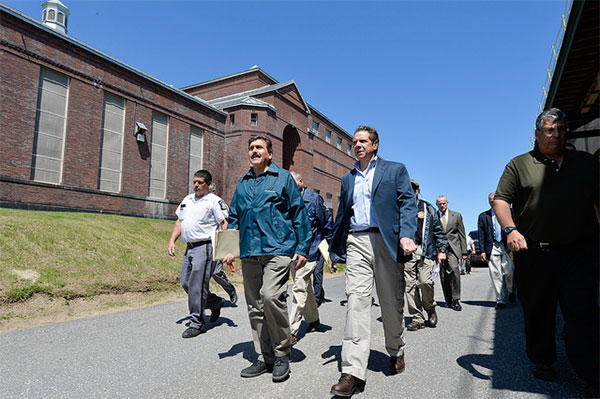
Gov. Cuomo at an update prison (Governor's Office)
Anyone following New York City politics knows about JustLeadershipUSA’s mission to close the jails at Rikers Island. In less than a year, the #CLOSErikers campaign successfully pressured Mayor Bill de Blasio to commit to shuttering the jail complex. It is no longer a question of if Rikers will close, but when. But the campaign has always known that closing Rikers would require reforms at the state level as well. An overhaul of our statewide bail, speedy trial, and discovery statutes is necessary to reduce the population at Rikers so that it can finally and expeditiously close its doors.
Even if Rikers were closed tomorrow, these reforms would still be necessary. While New York City has successfully reduced its jail population over the past few years, county jail populations across the state are growing. Today, 63% of people held in jail in New York State are held in jails outside New York City. Of those 25,000 husbands, fathers, brothers, sisters, children, and loved ones who are sitting in jails across our state, 70% have not been convicted but remain unjustifiably caged while they await the outcome of their cases.
This reality is a consequence of punitive and discriminatory criminal justice policies that have decimated communities, primarily poor communities and communities of color, for decades.
To end this human rights crisis, we need bold action from Governor Andrew Cuomo and our state Legislature. That is why JustLeadershipUSA launched #FREEnewyork, a campaign focused on empowering those who have been most harmed by our jails and prisons to hold Governor Cuomo and our elected leaders in Albany accountable and unapologetically demand real solutions to these self-inflicted problems.
Governor Cuomo said that Rikers should be closed in three years. Now he must deliver around the state he leads. He and his colleagues in Albany have both the power and the responsibility to drive us toward that Rikers goal while also addressing the failings of our statewide criminal justice system.
They can start with overhauling our broken bail system. We need reform that eliminates money bail, protects the presumption of innocence and the right to freedom, limits when and how any pretrial conditions are instituted, and prohibits biased risk assessment tools. Bail reform must focus on ending the devastating repercussions that even initial involvement with the criminal justice system can have on people, especially on low-income families who too often must choose between paying bills or paying for their loved one’s freedom. People who can afford bail achieve better outcomes in their cases, and everyone deserves access to these outcomes.
Albany must also enact comprehensive statewide speedy trial and discovery reform. Today, no other state in the country comes close to matching the appalling unfairness of New York’s readiness rule approach to ‘protecting’ one’s right to a fair and expedient process.
We need a true speedy trial law that sets concrete limits on when a defendant must actually be brought to trial. As it stands now, prosecutors can cause unforeseeable and unending delays in the trial process without significant repercussions. Combined with the current state of our bail laws, this leads to human beings trapped in cages while they await their hearing before a judge or jury.
What is already a bad situation is only made worse by New York’s current discovery laws, which are widely regarded as some of the most regressive in the country. We need a new discovery law that requires open, early, automatic, and mandatory discovery, guaranteeing defendants and their lawyers access to vital information about their cases. Without this, defendants and their attorneys have little to no access to information about the charges they face.
These reforms are vital for New Yorkers most affected by mass incarceration, and countless studies have shown that criminal justice reforms like these increase public safety, improve relations between communities and law enforcement, and create better outcomes for victims and taxpayers. Yet, while each of these reforms and each of their respective components are important, none are sufficient on their own if we truly want to end the plague of mass incarceration that grips New York State. Comprehensive, connected reforms are necessary for the real, lasting, and positive change in our criminal justice system that New Yorkers deserve.
Without this action at the state level, New York will continue to commit human rights abuses on a daily basis. The atrocities of our criminal justice system will linger, and New Yorkers will suffer unimaginable harm as a result. To fight for reform, close Rikers, and decarcerate county jails throughout New York State, directly impacted individuals and communities across the state must raise their voice, and, together, bring a simple message to Governor Cuomo and our legislators in Albany: we are watching you, we demand real and bold reform, and the time to act is now.
***
Glenn E. Martin is founder and President of JustLeadershipUSA. On Twitter @GlennEMartin and @JustLeadersUSA.
***
Have an op-ed idea or submission for Gotham Gazette? Email This email address is being protected from spambots. You need JavaScript enabled to view it.
Don’t Forget: Cumbo Won with Promise of 100% Affordability at Armory
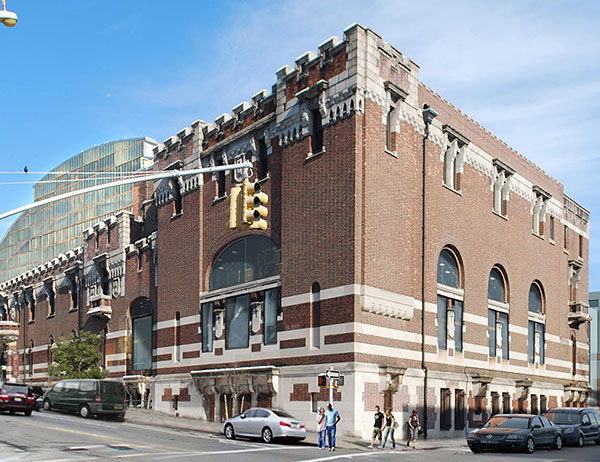
Bedford Union Armory rendering
For months, thousands of Crown Heights residents have petitioned, testified, marched, and protested against a proposed redevelopment at the Bedford Union Armory, where the plan backed by the de Blasio administration would take a massive parcel of public land and give it to a private developer to build high-end housing and a recreation facility.
The local City Council member, Laurie Cumbo, recently won her Democratic primary for reelection after opposing the deal, promising that she would insist on no luxury condominiums, while her backers promised she’d push for 100% affordable housing at the site. But Cumbo is now moving the goalposts in a dangerous direction.
Crown Heights is one of New York City’s most rapidly gentrifying neighborhoods. In 2015, over 20,000 families faced eviction in the three zip codes surrounding the armory, many of whom lived in the community long before it became a “place to be” for those moving into the area. Nearly 30% of shelter entrants in the city are from Brooklyn and if this project proceeds as currently designed, even more longtime community members (many whom are people of color and of West Indian descent), will be displaced from their homes and have to move to a shelter that probably won’t be across the street like the mayor’s plan suggests.
From the beginning, the community’s demand has been simple to understand. Kill this deal. Go back to the drawing board to create the truly affordable housing that’s desperately needed.
We need a community land trust with local control over the land, and real low-income housing. The only housing to be built should be to protect the victims of gentrification -- displaced homeless families and those at risk of displacement -- not to facilitate more of the same problem. It appeared that Council Member Cumbo had finally listened to her constituents when she opposed the plan currently on the table.
But in a recent New York Times article on the mayor’s housing plan, Cumbo declared that “the community put the line in the sand: no luxury condominiums.”
This “line in the sand” signifies a bait-and-switch. In fact, it’s simply where Cumbo has moved the goalposts after winning a competitive election, and the Council member should know that the community sees what’s happening.
Redevelopment of the Bedford Armory was the central issue in the recent primary. During the campaign, Cumbo supporters spent $135,846.64 on more than 10 mailers and robocalls in an effort to convince Crown Heights voters to support her. These mailers were clear on Cumbo’s position: shut the deal down without 100% affordability at the armory site.
Cumbo won promising a much better deal, and now she just wants to scrap the condos.
Let’s be crystal clear: a project that moves forward with any luxury housing – rentals or condos – is still not a project for us. A community land trust with real low-income housing would be a practical solution that could contribute to solving the homelessness crisis in Brooklyn and in New York City overall, especially since this is public land. But a housing plan that moves forward with only 18 units affordable to the average resident of Crown Heights is not just unacceptable, it’s an insult.
If Cumbo doesn’t kill the deal, she will have allowed her supporters to openly lie to the electorate during her primary campaign.
And to add injury to insult, Mayor de Blasio is busy explaining away his failing housing policies by blaming the constraints of the free market and capitalism. But those restraints don’t exist on public land like they do on private land. The Bedford Union Armory is a wholly socialist enterprise — like the mayor claims he would want.
What is the mayor doing with these “socialist” powers? Making a conscious decision to privatize land and “harness” gentrification, rather than fight it.
Public land is a vanishing resource in New York City. At a time when we continue to struggle with a record homelessness crisis and massive displacement of low- and moderate-income people, many people of color, it should also be priceless.
This is particularly egregious when more and more human beings are being warehoused in shelters, just like the one recently opened a few blocks from the armory, with a number of residents not being from the area, as the mayor claims is his goal. Despite what the mayor and Council Member Cumbo say in their press clippings and campaign advertisements, their policies show exactly where their priorities lie: luxury housing to make developers rich and house people who have no fear of being homeless, and shelters for far too many others.
It really is still a tale of two cities out here.
But Cumbo still has a chance to live up to the promises she made during her primary campaign, cutting out greedy developers and giving us a community land trust with 100% affordable housing on this precious public land.
Or she can get rid of a few luxury condos and tell us that this is some kind of victory, despite the fact that half the units would still be luxury rentals and a pitiful 5 percent would be affordable to the average Crown Heights resident, the same residents who have supported her.
We look forward to working with Council Member Cumbo on developing the community land trust this neighborhood needs, especially on public land, as we know she wants to do the right thing. There’s still a chance.
But make no mistake, we won’t let the wool be pulled over our eyes.
***
Monique “Mo” George is the Executive Director of Picture the Homeless. On Twitter @pthny.
***
Have an op-ed idea or submission for Gotham Gazette? Email This email address is being protected from spambots. You need JavaScript enabled to view it.
Our Youngest Students Deserve Great Teachers Too

(photo via @nycgob)
When your child starts his or her very first day of school, you do everything you can to prepare them for the beginning of their educational journey. But you might be surprised to find out that a new study shows there’s a good chance your school assigns one of their lower-performing teachers to kindergarten or other earliest grades. Although research shows that the earliest grades have an outsized impact on success later in life, administrators are in some ways incentivized to push their least effective teachers to early elementary because states often don’t test students until the third grade. That means that despite all your preparation and hopes, your child may have a struggling teacher to lay the foundation for his or her future learning.
Your child deserves a great teacher practicing in their element, regardless of whether or not they’re part of a state testing grade. Instead of “shuffling” our teachers, we need to dedicate resources toward helping our educators strengthen their practice. As New York and our entire country confront a national teacher shortage, it’s more important than ever to help our teachers rise to their full potential to become lifelong, excellent educators.
From what I’ve seen, we have a long way to go. Over the last five years, I have heard colleagues across the city describe how new and developing teachers are assigned to subjects outside of their skillset and training, rather than provided with the support to excel in the subject of their expertise. The story of one of these teachers, whom I will call Mary, best exemplifies the damage this practice is inflicting on both students and teachers.
When Mary began her career teaching fifth-grade math, she was full of energy and a deep commitment to help her students grow into analytical and enthusiastic mathematicians. But, as with most first-year teachers, Mary struggled with managing her students’ behavior, hindering her students’ learning and making every day a challenge. But despite a year that tested her resolve and often brought her to tears, her optimism remained. Mary believed that if she worked hard and received support and guidance from administrators, she could grow into an exceptional teacher.
Instead, after state test results were released, she was reassigned to the untested subject of K-3 literacy enrichment, a discipline requiring an entirely different skillset from math.
What Mary needed was the targeted and consistent training all teachers deserve. What she received was neglect. Isolated and out of her element, behavior issues in her class only worsened, and her bright outlook on teaching quickly dimmed.
The good news is that some schools, such as the Lillian Weber School of the Arts where I teach, are bucking that trend, demonstrating that supporting teachers like Mary is actually quite simple and cost-effective.
These schools provide professional development opportunities tailored to meet teachers’ individual needs and empower veteran teachers to be mentors who develop meaningful and productive partnerships with their less experienced colleagues. In addition, some schools have begun forming Professional Learning Communities that allow teachers to collaborate to analyze classroom strategies, learn and master instructional practices, and fine-tune their instruction based on student data.
In my school, our administration provides over six different topics for teachers to choose from, deepening our engagement and helping us build the skills to eventually facilitate our own five-week learning community cycle on topics that were once growth areas. With these and other methods, our schools can create excellent teachers. Purposeful and consistent support allows any educator to learn the skills to give our students the fluency to become readers, the number sense to become mathematicians, and the life skills to become leaders.
The short-term goals of strong standardized test scores are often at odds with the long-term goals of creating strong, curious learners. But this does not mean we should get rid of tests. Testing is important; it provides educators and decision-makers with crucial data that inform how we teach and how they allocate resources. But unfortunately, our system can encourage administrators to make decisions to immediately boost test scores rather than based on what is best for the school overall. Instead, we must invest in programs like Title II that provide meaningful learning opportunities for teachers. Rather than displacing our developing educators, we can build effective and invested teachers.
***
Jazlyn Mena is a STEAM/Data Specialist at an elementary school on the Upper West Side and a member of Educators for Excellence. She is passionate about access to quality STEM instruction and improving school climate for New York City students.
***
Have an op-ed idea or submission for Gotham Gazette? Email This email address is being protected from spambots. You need JavaScript enabled to view it.
An End-of-Term Agenda for the City Council Veterans Committee
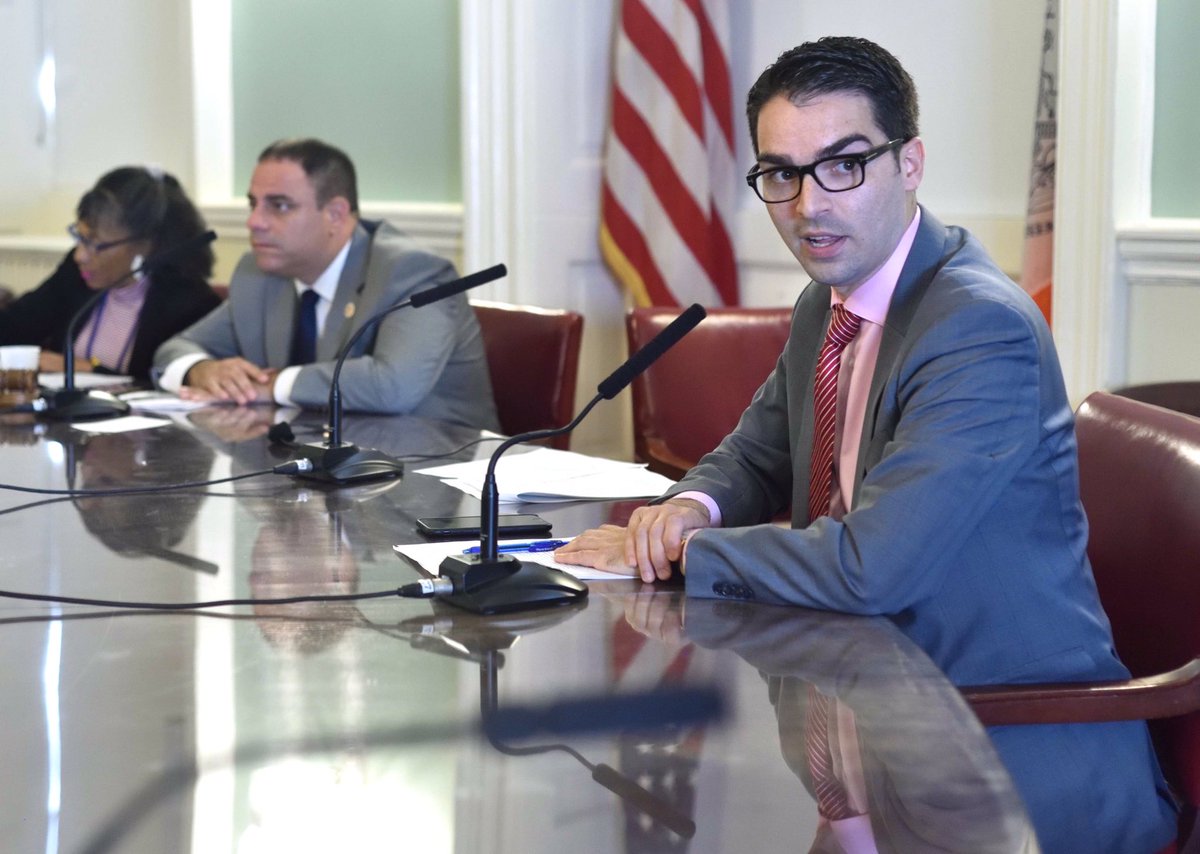
Council Member Ulrich (photo: John McCarten)
In early 2014, City Council Member Eric Ulrich was appointed chair the veterans committee by Speaker Melissa Mark-Viverito. At that time I wrote that no one within the veterans community knew what to expect, and as one of a few Republicans in a largely Democratic City Council, there were some who opposed Ulrich’s selection.
Fast forward nearly four years and the majority of the veterans community agrees that without his leadership and guidance, there would not have been a renewed conversation and there certainly wouldn’t have been many legislative accomplishments, particularly the creation of the Department of Veterans’ Services (DVS). I dare say that Ulrich’s record of accomplishments, along with Council Member Paul Vallone and the other veterans committee members, has been the greatest within the Council since I started as an advocate back in 1995.
With the general election coming next month and the race for the next Speaker already hot, there are some who believe that if re-elected, Ulrich may be moved to chair a new committee by the next Speaker. There are many moving part to this equation, but given the final three months of this Council’s term are upon us, there is some important veterans business to take care of.
The veterans committee held a hearing earlier this week, and with that and the ticking clock in mind, there are several topics the committee should consider holding hearings on over the coming months.
Department of Veterans’ Services: This week the veterans committee held an oversight hearing on DVS. This hearing focused on the growth and accomplishments of the agency since it came online in April 2016.
Overall, many agree that there have been a number of successes, but growing pains and confounding issues as well. While DVS leadership touted the department’s work and successes, particularly with its integrative health model (VetsThriveNYC), its work regarding housing homeless veterans, its Public Artist in Resident program, and its information and technology, many items remain.
Procurement of its VetsConnectNYC program, an online platform that will connect veterans with service providers, is still being negotiated. Veterans are concerned about information missing on DVS’ website, its lack of inclusion in the Mayor’s Management Report (MMR), which DVS reps acknowledged will be in the next report, and the functions and actual outreach of the Community Outreach Specialists.
Lastly, many veteran organizations receiving money from the City through the Department of Youth and Community Development (DYCD) have stated that DVS needs to have autonomous control over contracts to speed up the contracting processing and disbursement of funds, particularly for those veteran organizations that have unique contracting situations. This issue should be considered for a separate hearing with the Council’s finance committee.
Veteran Treatment Courts: Almost two years ago the committee held a hearing regarding Veteran Treatment Courts throughout the city; as well as Council Member Rory Lancman’s proposed legislation calling for the creation of a Veterans Legal Task Force to study veterans’ access to legal services and resources within the city’s criminal justice system. Unfortunately, that bill, Intro. 793, didn’t make it out of committee, however with Congressional Rep. Dan Donovan’s recent announcement of grants for Veteran Treatment Courts; and the Manhattan veterans court up and running, the time is right to revisit this issue to see what the courts are doing, learning, learning from each other, and how they have evolved in helping veterans from all eras.
Veteran Homelessness: In 2009 there were roughly 3,700 homeless veterans in New York City. At the end of 2015 the federal government announced that New York City had ended chronic veteran homelessness, meaning veterans homeless for long periods of time or repeatedly. That is a major accomplish that could not have taken place without a coordinated approach from federal, state and city agencies.
In November 2015, the Council’s veterans committee, in conjunction with the general welfare committee held a hearing on what the city was doing to provide services to veterans, especially those experiencing homelessness. With the recent announced reductions of SSVF providers last month, along with the city not reaching “functional zero” and the federal VA dropping that goal recently, an update is needed in regards to what the veterans homeless population looks like, where the dity is in maintaining the end of “chronic homelessness” for veterans and what the plans are to address any future changes that may come from the federal government. This hearing also needs to solicit input from non-profits that are working on the ground with this population.
Veteran Small Business and Entrepreneurship: Almost three years ago, the veterans committee, along with the small business committee, held a hearing on supporting veteran-owned businesses. This was based on Local Law 144 of 2013, which required the Department of Small Business Services (SBS) to study veteran-owned business enterprises and determine the need for a city veteran-procurement program.
In December 2014, SBS, the Mayor’s Office of Contract Services (MOCS), and the then-Mayor’s Office of Veterans Affairs (MOVA) published a report of their findings, which the committees examined at a January 2015 hearing. The report contained seven recommendations, which included increasing outreach to veterans, better training veteran business owners (VBOs) on how to do business with the city, and creating a designation for VBOs who wish to be potential vendors with the city.
There was also discussion of supporting the development of a veterans business enterprise program (VEB) through executive fiat (as a pilot program) or by working with the City Council to create legislation for the program. With the rise of veteran entrepreneurs over the last couple of years, there needs to be a hearing to update what has changed and where DVS and SBS are with this issue.
Lastly, the committee should also consider follow-up hearings regarding the City University of New York (CUNY); as well as from DVS regarding its new public-private partnership “Veterans on Campus-NYC.” The committee should consider holding a hearing on the overall veterans population in New York City and should hold a hearing in the Bronx, as Council Member Ulrich promised to Council Member Fernando Cabrera earlier this year.
This is a fairly hefty agenda and some issues will certainly get left off the table. However, if Council Member Ulrich and the committee members continue to approach veterans’ issues with the diligence they’ve shown over the past three and a half years, they will have a busy and productive next few months, and leave the committee in a much better place for whoever follows.
***
Joe Bello served 11 years in the U.S. Navy/Naval Reserve and has been a veterans advocate in New York City for over two decades. He is a member of the City’s Veterans Advisory Board and the founder of NY MetroVets.
***
Have an op-ed idea or submission for Gotham Gazette? Email This email address is being protected from spambots. You need JavaScript enabled to view it.
The Most Important Step to Reinvigorating Our Democracy
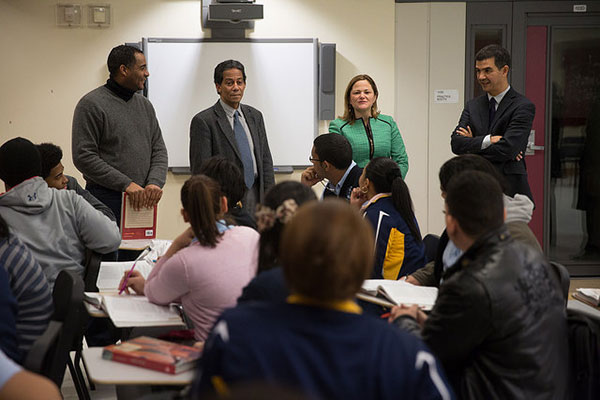
Council Speaker Mark-Viverito (in green) visits a school (photo: William Alatriste)
As we reflect on the recent September primary election in New York City -- where only 14% of active registered Democrats actually cast a ballot, a 53 percent drop in turnout compared to the 2016 Democratic presidential primary -- we are concerned that the city citizenry is not adequately prepared for responsible voting. But, how can we expect young people, or adults for that matter, to participate in our democracy if we have not educated them to do so?
Many have blamed turnout woes on a lack of enthusiasm for candidates or structural voting challenges. Though there are certainly reforms to be made, instead of only perpetuating this blame, we can and should aim to inspire more participation throughout the city. A bold idea at this critical moment in our national and municipal history to increase voter participation and civic engagement is to reinvigorate civics education in New York through a new, engaging pedagogy: Action Civics.
Action Civics is a student-centered, project-based approach to delivering participatory civics education to young people. This is not your grandmother’s civics. Instead, the innovative approach to civics education begins with teacher-student interactions in the classroom, and ripples outward to help students identify community challenges, name root causes, and propose concrete solutions, which often engage local government to remedy those challenges.
This community-minded and outreach-intensive strategy provides a multitude of benefits: Action Civics gives students the key civic knowledge, skills, and motivation to develop regular voting habits, while furnishing additional motivation for teachers, parents, and other stakeholders to start or recommit to consistent voting and civic engagement themselves.
New Yorkers can boast of tremendous civic accomplishments—a public transportation system that, until the more recent constant subway delays, was the envy of the country; world-class parks in every borough; an amazing array and concentration of arts and cultural institutions; and the nation’s largest public school system, to name just a few. The city’s many accomplishments must not be taken for granted, though. As New Yorkers, we are always looking to the next frontier. Living up to our full civic potential requires a renewed commitment to preparing our young people, and all residents of our city, to exercise the franchise as educated and empowered voters. What better stage of development to begin this process than with our youth, in our classrooms?
To be clear, Action Civics is not the same as conventional civics education. Traditional civics, the mere mention of which can cause a yawn, assumes that increasing awareness about how our political system works, and rote memorization of the names of candidates and key provisions of the Constitution, is sufficient for educating and mobilizing current and future voters.
We could not disagree more. Civic knowledge is important, but must be supplemented by civic participation that adopts a “learning by doing” pedagogy.
We have found, for instance, that educating students about how to take action -- for example to advocate for the Department of Transportation to install a pedestrian safety signal at key intersections to address hit-and-run accidents near their school or pushing the State Education Department to update the outdated health education curriculum to ensure that students are educated about how addictive opioids are given the epidemic plaguing their community -- is a more effective pedagogical approach than a textbook-first experience with democracy. Not only are students taking action, but they are learning how city government or the State Education Department actually works, and who elected and appointed officials are accountable to.
Local election officials matter, not just who the President is, and Action Civics helps young people understand that in a very real way, leading to increased interest in local elections.
In a few short weeks, on Election Day, New Yorkers statewide will be presented with a back-of-the-ballot question: “Shall there be a convention to revise the Constitution and amend the same?” Given this unique, once in 20-year opportunity, should it be left to chance that young (or older) people will be sufficiently informed and prepared to understand the importance of this ballot question? Will they know how to take action to advocate in support of or against such a convention? We think not, which is why we released lessons for teachers to educate 8th- through 12th-grade students about this rare opportunity.
But this is only one example highlighting the urgency of ensuring that all students statewide receive an effective Action Civics education, focused primarily on local issues.
Advocates have consistently pushed and seen tabled reforms to modernize New York’s antiquated voting laws. While enacting those reforms should remain a priority, boosting voter turnout in New York requires a more long-term vision to improve our democracy, focused on empowering citizens themselves.
Action Civics holds the promise for the future—it is a transformative, long-term investment in the health of our democracy. That is why Speaker Melissa Mark-Viverito and the New York City Council made a bold investment in Action Civics through the Civic Education in City Schools initiative allowing Generation Citizen to bring its rigorous, standards-aligned curriculum to approximately 3,4000 New York City public school students in the 2016-17 school year. And, they renewed their investment in New York City’s young people again this school year.
We know New York’s young people need this approach, but implementing it citywide and, ultimately, statewide will take substantial resources. Now is the time for all of our city and state leaders to partner with us, and the broader civics education field, to bring true Action Civics to secondary students in New York. Then, we can dream of a day with a vibrant local democracy, in which the vast majority participates in local elections.
***
DeNora Getachew is Generation Citizen’s New York City Executive Director. On Twitter @DeNoraGetachewDeNoraGetachew and @gencitizen.
***
Have an op-ed idea or submission for Gotham Gazette? Email This email address is being protected from spambots. You need JavaScript enabled to view it.
Positive School Culture, Not Metal Detectors, Keeps Kids Safe
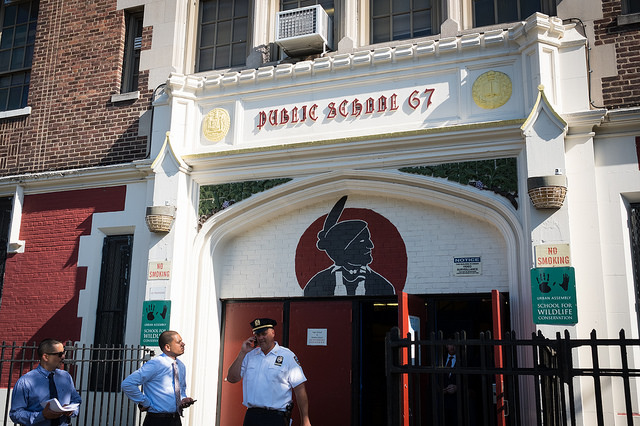
(photo: Edwin J. Torres/Mayor's Office)
Two boys’ lives are obliterated after Abel Cedeno, age 18, used a switchblade to stab Matthew McCree, 15, and another boy who had reportedly been bullying Cedeno during their history class, as classmates looked on. McCree was pronounced dead shortly after. Cedeno was arrested on charges of murder, attempted murder, manslaughter, attempted manslaughter, assault and criminal possession of a weapon. After a brief court appearance Cedeno was held without bail and his lawyer requested a psychiatric evaluation and that he be placed on a suicide watch.
This extreme incident of school violence and loss of a young life is shattering to many, including students and teachers in the school -- the Urban Assembly High School for Wildlife Conservation in the Bronx -- and students and teachers across New York City who imagined this horrific event as the media presented it to us.
The murder of a student in a school, the very institution that is charged to educate and nurture children, underscores that current policies leading to high concentrations of poor students, many with special needs, in de facto segregated schools, do not allow schools to safeguard children's lives, let alone meet their potentials as democratic organizations and pillars of our society.
But without politicians, education leaders, and the public acknowledging the core issues at play in such schools -- devastating poverty, unemployment, stress of the working poor, violence, underprepared and emotionally traumatized youth, among others – and calling for an end to Department of Education practices that place high concentrations of poor and special needs students in segregated schools, there will continue to be disastrous failure. As education scholar and activist Pedro Noguera put it, school reforms cannot “ignore the unmet social needs of children” related to concentrated poverty. When they do, students fail and are failed by the school system.
When the tragic story in the Bronx broke, the most immediate and loudest response was demand for more metal detectors. Why did the school not have them, devastated and outraged parents wanted to know. What went wrong? Who is to blame?
There are those who blame inadequate school security, including the lack of metal detectors. Others accuse the two boys who allegedly taunted Cedeno in class. Others blame the attacker’s family, his background, his mental state. Others accuse the new principal of poor leadership. They all miss the central lesson of this tragedy. Ultimately, a deprived school culture is at the heart of the horror that led to the death of a student at Wildlife.
Incidents like these rarely happen in the moment but are the result of weeks, months, or years of intersecting and harmful factors at play. To have a full understanding of what went wrong that day, a multidimensional examination is required, as this incident is embedded in economic, social, demographic, historical, political, and educational factors that, when entangled, lead to less publicized tragedies in schools across this city.
Relevant demographic data about the 585 students at Urban Assembly High School for Wildlife Conservation includes: the student body is 71 percent Hispanic, 24 percent black, and 27 percent students designated learning disabled in some way. Nearly one-third of the students in the school have special psychological or cognitive needs. Fully 100 percent of the children in the school are eligible for free or reduced lunch, meaning that all of them are poor.
The school’s college readiness rate is only 23 percent, meaning that less than one in four students are prepared for college upon graduation. Seventy-four percent of the kids report there is bullying in their school. Only 21 percent of the kids say classmates treat one another with respect. Just 31 percent of the teachers in the building report that they trust the leadership, including the principal. The leadership had essentially been a revolving door for three years, with an exodus of teachers and instability infiltrating the school community at every level. (Data found on Insideschools.org.)
Based on news accounts, comments by former teachers at the school and independent reviews by Insideschools.org, Wildlife has a culture shaped by poverty, segregation, neglect, attitudes from inside and outside the school building about poor kids of color from the Bronx, and a system that “dumps” high concentrations of students in poverty, many with special needs, in one building and not another.
In this school, as in other New York City public secondary schools I have taught in or visited over nearly 30 years, many teachers care deeply about students and work tirelessly to help them succeed. But, no matter how deeply a teacher wants her students to succeed, teachers’ work is inevitably shaped, and limited by, the social, economic, historical, and political dynamics of the school itself, by the approach to school leadership employed, available resources, and oftentimes school size (small schools can offer adolescents a sense of community, which they usually require to thrive).
The teachers at Wildlife work in a school where the vast majority of students do not experience success in an academic setting, many repeat Regents classes and exams, and many struggle with reading, writing, and meeting grade-level standards, which many of them feel are unattainable, impossible, perhaps futile. Rather than having a culture of success, schools such as Wildlife become environments where both students and teachers learn to cope with degrees of failure, with the “opportunity gap” often the elephant in the room.
One can enter a school building and know fairly quickly whether or not it is an effective and positive place for learning, teaching and kids. School leadership experts describe positive school cultures as having “a shared sense of purpose and values” and supporting “continuous learning and improvement.”
Ultimately, a “good school” has a caring and positive school culture ensuring that students are heard, seen, cared about and pushed to develop. In a “good” school, all adults understand that relationships matter in learning and the leadership supports the development of positive and caring relationships among teachers, students, and their families. This includes a commitment to viewing students as multifaceted young people who are more than their test scores and school preparedness, so they can be supported to develop in positive ways through adolescence and into adulthood.
In the business community, it is widely accepted that efforts toward building a positive work culture can lead to increased innovation and productivity. Such truths are well-known, but how they can be applied to a high-poverty school setting is merely an academic exercise if the school faces a barrage of stressors -- including high percentages of kids with cognitive or psychological needs, high concentrations of underprepared and underachieving students, emotionally traumatized youth, violence, and de facto segregation -- as is encountered at Urban Assembly High School for Wildlife Conservation every day.
Schools like Wildlife face a “perfect storm” that cannot be tackled by strong school leaders, devoted teachers, and installing metal detectors. The problems Wildlife faces were created over time by a multitude of attitudes, policies, and practices that link with societal issues confronted by poor, minority communities across New York City, and originated beyond the walls of the school building. Who or what is to blame for the killing of a boy in school? The destruction of these two young lives call for an answer to this question and the search for honest solutions.
***
Sonia E. Murrow, a former social studies teacher in New York City, is an associate professor of education at Brooklyn College.
***
Have an op-ed idea or submission for Gotham Gazette? Email This email address is being protected from spambots. You need JavaScript enabled to view it.
Disaster Preparedness Requires a 211 System; New York City Still Doesn’t Have One
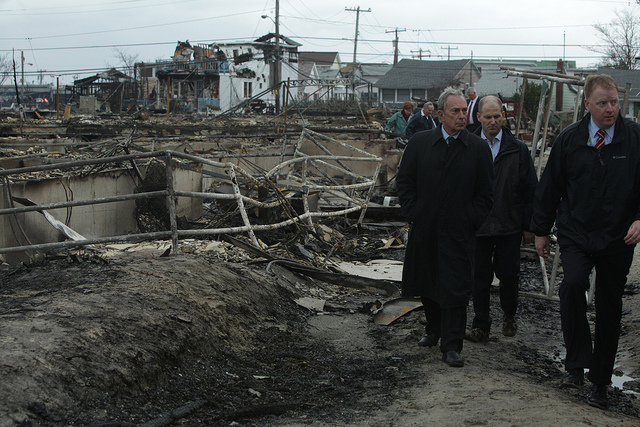
After Sandy (photo: Ed Reed/Mayor's Office)
Over the last few weeks, New Yorkers have watched with great anxiety as Texas, Florida and Puerto Rico, among many other places, were pummeled by massive hurricanes. Whenever we see storm destruction, memories of Sandy re-enter our consciousness; as does the question: Is New York City significantly better prepared for the next big one? My answer is “No.”
As a technology professional in disaster management, I’m constantly on the lookout for better ways to use software tools and information management practices to improve a city’s resilience. With new technologies coming out all the time, there are many pathways for improvement, and selecting the right place to focus preparedness efforts is never easy. In New York City’s case, however, it’s pretty simple: one of the most impactful things we could do, and certainly the lowest hanging fruit, is to build a canonical directory of all the health, human, and social services available in New York City so people know where to go to get the services they need before, during, and after a disaster.
The directory system I’m proposing is often called a “211 system.” In almost every major U.S. city and in over 90% of counties, if you call 2-1-1, you’re connected to a directory assistance representative that can refer you to the health and social services that meet your needs. If you call 2-1-1 in New York City, you’re connected to our 311 system — which is good at providing basic information about government services, but isn’t able to refer you to the vast majority of nonprofit services available in the city.
211 systems are essential infrastructure for any coherent social safety net. Indeed, without them we don’t even know what the social safety net looks like! These systems enable people to find a huge array of help for a broad collection of things, including: housing, employment, food, children’s services, domestic violence counseling, and so much more.
Without a 211, social workers are left to solve this information problem on their own. Many create their own lists on paper and in Word documents that they share with each other. Some organizations maintain resource directories for certain kinds of people or neighborhoods. Well-funded institutions even pay for-profit companies to find this information and provide it to their clientele.
Our lack of a real 211 system is a hindrance to every nonprofit and government service provider, and an embarrassment to every politician who claims to care about New Yorkers in need. If they really cared, wouldn’t they make sure it was possible for every New Yorker to actually find the services they're entitled to receive?
Prosperous and powerful New Yorkers tend to be unaware that the city lacks a 211 system because they rarely, if ever, use nonprofit social services. But when a disaster like Sandy happens, many people who never before needed access to nonprofit services suddenly do. Because of this dynamic, 211 systems serve extremely important functions during disaster recovery by providing a canonical sources of information about services for survivors. They also tend to become the centers that convene and facilitate collaboration between government agencies, nonprofits and community groups.
211 systems in New Jersey and Long Island played this role after Sandy, and by most accounts their recoveries went much smoother than New York City’s. In New York City, no local entity took responsibility for organizing all the nonprofit service information, which led to a massive coordination crisis. Things got so bad that some intrepid FEMA staff created a 211-style services directory themselves, even though it was so far outside their traditional responsibilities that they had to pretend that other organizations had created it out of fear of political backlash. To this day, no one in city government or the nonprofit establishment has taken responsibility for these coordination failures. Nor has any agency or organization taken responsibility for ensuring that it never happens again.
While incremental improvements in disaster management and recovery processes have certainly been adopted over the last five years, one of the most important Sandy lessons is that New York City desperately needs a fully-funded and well-functioning 211 system. Until we have one, New York City cannot claim to be following even the most basic best practices in disaster preparedness.
…
Devin Balkind is a candidate for New York City Public Advocate. He is also the President of the Sahana Software Foundation, a nonprofit organization that produces the world’s most popular open source software platform for disaster management. On Twitter @DevinBalkind.
***
Have an op-ed idea or submission for Gotham Gazette? Email This email address is being protected from spambots. You need JavaScript enabled to view it.
My Crowded School, Like Many Others, Needs a Plan

(photo: Ed Reed/Mayor's Office)
Well-regarded New York City schools are super, and they can do anything. At least that's what they seem to think over at Tweed, home of the Department of Education (DOE). That's why my school, Francis Lewis High School, has 4,683 students at my last count, more than ever, in a building designed for 2,400. We're seen as successful, so a lot of families want their kids to go there. Generally I've agreed, but it's getting to a point where I'm not sure.
I’ll admit outright that I’m partial to our school. I’ve been there 23 years and I’m one of its biggest cheerleaders. Nonetheless, our situation is far from unique. According to DOE data, 550,000 students, fully half of those in the city, are stuffed into overcrowded schools.
How bad is it? Last week I counted 101 oversized classes. That's better than the 268 I counted the first day, but hardly ideal. Ideal, and also mandated by union contract, by the way, is zero overcrowded classes. Every single teacher, as well as basic arithmetic, will tell you that the fewer students there are, the more attention individual teachers can give individual students.
With new students walking in each and every day, and enrolling in the school, I’m not ready to celebrate just yet. The whole process fills me with something not remotely resembling optimism. I’ve counted classes of over 40 students. The city already has the highest class sizes in the state. Thirty-four, becoming the standard rather than the exception these days, is tough. Over 40 borders on impossible for a mere human, and is no help whatsoever for struggling students.
We have two rooms that are converted closets. They have no windows. Inside are indoor air conditioners and HEPA filters designed to make them more bearable. In practice, the A/C units are so loud that they preclude instruction. Some teachers turn them off whenever conversation takes place. Via inertia, they tend to remain off all the time. On sweltering days they must border on torture chambers.
The principal, to his credit, has given up his conference room to be used as a classroom. There are mostly honors classes in there so as not to freak out teachers who have a thin wall with the principal sitting on the other side. It's not quite perfect, though, particularly when the classes are oversized. It’s tough enough handling normal classes in odd spaces.
For my part, I've given up office space as union chapter leader and won't be demanding it back any time soon. But that's a drop in the bucket.
It's tough to get up and down the stairs sometimes. No one pays attention to up and down staircases, no one ever has, and no one ever will. If the movement is up and you want to go down, you have to fight the crowd. Recently, for the first time ever, I had trouble leaving the building. The movement was from the trailers -- did I mention the trailers? -- to the building and I was going the other way. I decided to try to turn around but was too far in to do so. I was fortunate that some students decided to move out of the way and let me through.
We are slated to get an annex in two or three years, assuming the DOE works on schedule. That's a big assumption. After all, Bloomberg was going to get rid of trailers years ago. We'd be pretty much unable to function without them. Ours are going to go when the annex goes up, and there are 20 learning spaces slated for the annex. Assuming we lose the trailers and the two closets as classrooms, we'll have a net gain of 10 classrooms. Given the explosion of students we face, I’m no longer sure that will fix our issue.
One key point: the DOE doesn't cap neighborhood schools like ours. So if people come in from other neighborhoods, other states, or other countries, they can send their kids to our school. In fact, there are two huge Marriott hotels, not yet open, freshly constructed across the street. Anyone staying there long-term could place their kids with us.
Nine years ago the United Federation of Teachers (UFT), with the principals union, the DOE, and our School Leadership Team, was able to come up with a plan to stem enrollment. Over the last few years the city has ignored that plan, with increasingly negative results. Prospective students used to need something like an electric bill to show residency. Now they just need an affidavit, something that basically anyone could write. I don’t want to turn away district families that want to come to our school, but I’d like to maintain our school as a place those families want to come.
Just before we made our agreement with the city, when we were approaching the enrollment we now have, a reporter asked me what the breaking point was. I told her I didn’t know, but I never wanted to find out. Our agreement with the DOE enabled us to help make the number of students more closely suit the space in our building. A few years ago we had closer to 4,200 students with a goal of 3500.
I’m a lowly teacher, and I saw this coming. It’s time for the important folks at Tweed to stop twiddling their thumbs and start earning their hefty salaries. Maybe their offices would be better used as classrooms. Or maybe they could rent space for us in one of the Marriotts.
In fact, I’m told the city has a plan to reduce our enrollment by 100 students a year, beginning next year. That’s fine, but it’s too little too late. I don’t want to begrudge a single student a single place in a single school, but I also don’t want to find out what our breaking point is. I still don’t know what it is, and I still don’t want to know, but it doesn’t feel far off. If the city doesn’t want to know either, they’ll find us alternate space right now. Waiting is the worst idea and not an option.
***
Arthur Goldstein is an ESL teacher and UFT chapter leader for Francis Lewis High School. On Twitter @TeacherArthurG.
***
Have an op-ed idea or submission for Gotham Gazette? Email This email address is being protected from spambots. You need JavaScript enabled to view it.
With Federal Help, A Big Project Reset Shows the Way at NYCHA
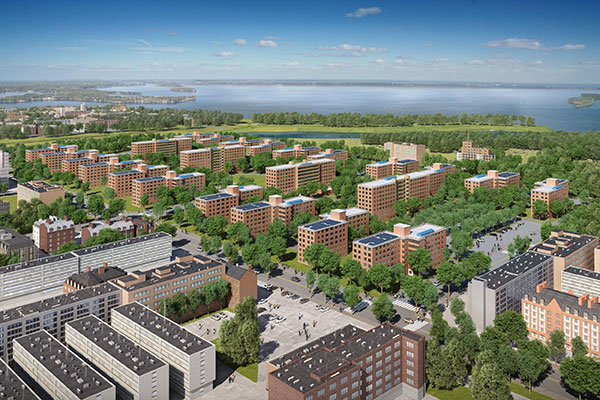
This is the second in a two-part series on transformations and experiments happening at NYCHA. Read part one: At NYCHA, A Small Project-High Concept Reset.
The conversion of the Ocean Bay (Bayside) project, housing 4,000 Rockaways residents, to private management through the federal Housing and Urban Development’s Residence Assistance Demonstration (RAD) program is far advanced. Ocean Bay flooded badly during Superstorm Sandy and has been on temporary boilers since the floods. While the damage was most severe to the mechanical systems rather than apartments, lobbies, elevators, or interior hallways, post-Sandy the complex continued to decline with problems of trash, leaking ceilings, and more.
Ocean Bay is also isolated: close to the beach and other housing projects but not much else. There isn’t a decent grocery store, or much of any stores or community services, within walking distance. But there are assets, if you know where to look.
The first major asset is the 1,395 apartments in 24 towers, nearly all still occupied by now former NYCHA families. Livable apartments in hot-market New York City are attractive opportunities, particularly if they are, as is the case here, delivered without an underlying mortgage. To simply develop the equivalent number of housing units might costs as much as $750 million (1,400 units at $400,000 each), take years of permits, incur many delays, etc.
Similar dilapidated public housing units would be less valuable in other cities, and many towers of similar scale and style have been destroyed across the country, but New York is different because of the demand for all housing, public or private.
The second major asset is the multiple set of government subsidies available to the developer. RDC Development, a joint venture between MDG Design + Construction and Wavecrest Management Team, has borrowed money in private markets that might not be available in less desirable housing markets. Most of the $560 million in renovation funding, including private loans, is also secured by the government including a future role for Section 8 (for operating support), FEMA (resiliency for future storms), federal Low Income Housing Tax Credits (attracting private-sector lending), New York State’s Housing Finance Agency (state-secured financing), and NYSERDA (energy conservation).
When you put all the layered subsidies on top of mortgage free units, you start to understand private-sector interest in these conversions. The developer expects to collect developer fees and some construction profits; the management company, Wavecrest, will also be able to collect management fees in the long term if all goes well.
It would be wrong, however, to view this conversion as easy money. The developer is taking a major risk on the current tenants as the future rent returns plus government subsidies will have to be sufficient to operate the buildings, maintain them, pay management fees, and cover the debt service. The developer/management will also have to keep NYCHA management happy in the long term, including using NYCHA waiting lists for future tenants, despite whatever shifting political winds may come along. And no one knows what will happen to federal housing subsidy programs in the coming years.
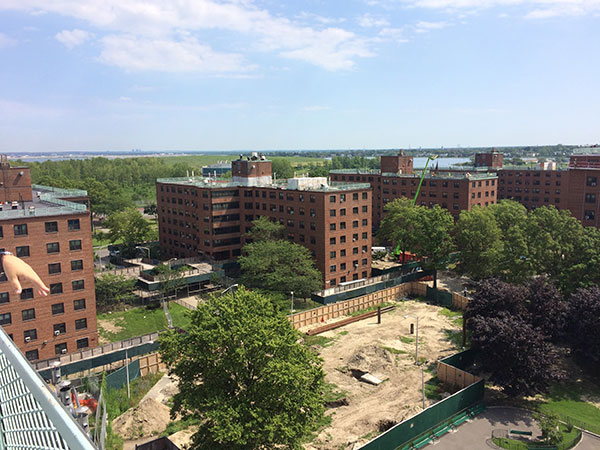
Redesigning What Matters First
The layout of the complex is moderately attractive by NYCHA standards. The four central towers are just nine stories tall each, so most of the apartments at Ocean Bay are located in the 20 six-story buildings flanking the central high rises. The grounds, despite having flooded, boast mature London Plane trees. The complex was moderately updated during the Hope VI process two decades ago including some cosmetic improvements to the grounds, elevator lobbies, and apartments.
The apartments are decent size by NYCHA standards and quite a few are very large (five bedrooms). The developer has a solid eye to what matters for resident satisfaction. Some of the original apartments were in very poor shape, with severe water damage, but most apartments have required upgrades and moderate renovation rather than gutting. The developer is thus switching out cabinets, laying down new vinyl strip floors, updating bathrooms, patching ceilings, and so forth. Current apartment configurations will remain as is. The apartments turn out respectable as a result of these modernizations; costs and complexity remain within the parameters of a renovation project.
 |
 |
Big-ticket, long-term quality of life repairs are the focus of building-wide renovation. The developer is adding a more reliable and efficient heating system (on the roof to avoid future floods), new roofs, new windows, lintel brick repointing, lobby renovations, solar panels, and a protective berm and water retention swales. The developer is deferring cosmetic exterior additions and extensive landscape plans, which are still planned, until the site has been stabilized and any unexpected problems are addressed.
Delivering quality basics today means steam-cleaning and shining up existing floors and glazed brick halls inherited from NYCHA, widening the trash chutes that often overflowed, and running an expensive, and more efficient, heating system along those hallways. It means new windows that are similar in look to the old ones, but open more easily to help aid air circulation. It means new cabinets that provide an immediate sense of improvement. It means a protective berm for future floods and resilient electrical system. It is these investments that will distinguish the project in terms of livability from other postwar NYCHA projects in the years to come.
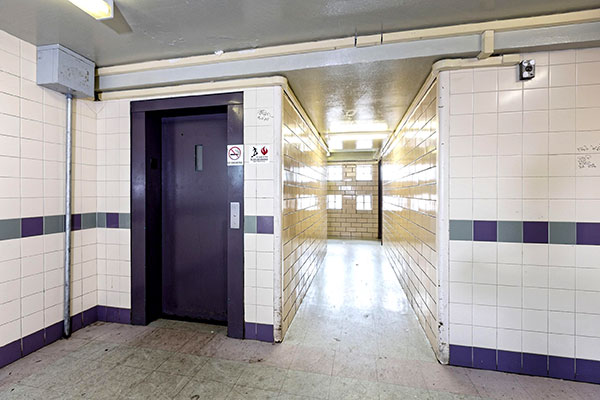
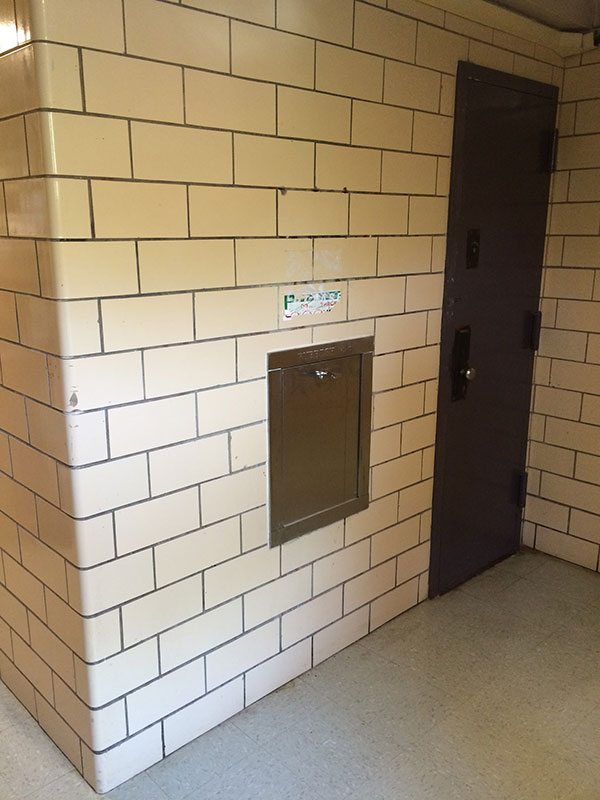 |
 |
The private management has also dispensed with NYCHA’s expensive labor system. This change has financial implications (lower operating costs) in the long term. Wavecrest, an experienced property management company, is now in charge of the entire complex—from rent collection to general maintenance. NYCHA employees opted to be moved to other NYCHA properties rather than transition to Wavecrest which would have meant more modest benefits, looser work rules (under a new union), and higher expectations.
The aim of the renovation and new management is to reset the tenant-management relationship and collect rent more consistently than NYCHA by being a better property manager. Wavecrest’s management fees, and the financial security of the property, is dependent upon steady rent collection. If Wavecrest can maintain higher standards in the long term, the project can enter a new era of stability. So far, says the developer, the rental collection under private management has been meeting expectations. It should be noted that the developer cannot, like Mitchell Lama conversions, rent empty apartments at market rents. This project thus retains its deep affordability for the foreseeable future.
Families accustomed to NYCHA’s de facto tolerance for late or no payment, and significant amounts of problematic behavior in courtyards and hallways, will need to adjust to private sector standards. The signs are encouraging that the new environment is already improving the quality of life. The developer reports reductions in the level of graffiti and other costly damage.
The developer is not, however, relying on resident satisfaction alone. Ocean Bay is massive, at 33 acres, with many entrances, stairwells, hallways, etc. It is also isolated and the neighborhood retains an air of disinvestment. The developer, per consultant advice, plans to install an electronic fob system for entry and movement through lobbies and other building private spaces, typical of market-rate buildings. In addition, 400 cameras will be installed across the site. These will be actively monitored by a private security company out-of-state. Security staff observing project activities will not only be able to report problems to the police, but will be able to speak directly to people caught on camera through a broadcast system. The aim of this “voice of god” is to help tenants feel the management presence -- in a good way, we hope.
There are plenty of additional opportunities for upgrades. NYCHA and the developer decided to delay but not rule out infill development of large open spaces within the project. Ocean Bay could benefit from additional housing or commercial operations that would enliven the area. Additional affordable housing units would also be welcome. In Europe, for instance, large and isolated public housing projects have been infilled with a mix of subsidized, market, and retail buildings to reduce the isolation and create more lively communities. Yet Ocean Bay has so many upfront issues that stabilizing the project as a living space came first. Infill is also politically controversial and can be a distraction. Without any additions, Ocean Bay already offers tenants a higher standard of living, but will also remain both geographically and socially isolated for the time being. The beach is, however, just a few blocks away.
This is the second in a two-part series on transformations and experiments happening at NYCHA. Read part one: At NYCHA, A Small Project-High Concept Reset.
***
Nicholas Dagen Bloom is an Associate Professor at NYIT and author of “Public Housing That Worked.” Matthias Altwicker, AIA, is an associate professor of architecture at NYIT and principal and founder of Studio A+H.
***
Have an op-ed idea or submission for Gotham Gazette? Email This email address is being protected from spambots. You need JavaScript enabled to view it.
The MTA’s Long-Term Financial Problem Is Severe and May Soon Be Worse

(photo via MTA)
Summer 2017 saw a political breakthrough for mass transit riders when Governor Cuomo declared a “Transit Emergency“ after the Harlem subway derailment, effectively acknowledging the State’s responsibility for addressing the deteriorating and delay-plagued subway, bus, and commuter rail system.
Within a month, the MTA’s new Chair, Joe Llota, proposed an $836 million “Subway Action Plan” to address the emergency, meaning major upgrades to the MTA’s maintenance operations and other investments to attack the constant delays and bring some meaningful relief to riders. He proposed the MTA and the State split the cost of the new program with the City, which drew a near immediate rebuff from Mayor de Blasio.
The MTA began implementing the plan, deploying late-night work crews on system segments to clean debris and fix track and signals, without a clear answer to where it will get the money. The Subway Action Plan became part of the MTA’s constant dilemma - where can it pull together resources for both its short-term and its long-term needs, which are far larger than the $836 million action plan. Seemingly aware of this, the emergency declaration and the subway action plan response precipitated another move by Governor Cuomo.
In mid-August Cuomo endorsed “congestion pricing,“ claiming it was “an idea whose time has come.” Congestion pricing puts a toll on the free East River Bridges into Manhattan, as well as a toll for vehicles crossing 60th street toward the city’s business district.
The money from the tolls would provide the cash to repay money the MTA generally borrows for its capital needs. Those needs include buying new subway cars and buses, replacing track and signals, rebuilding stations, elevators, escalators, and railyards, continuing expansion projects like the Second Avenue Subway and East Side Access, and installing computer-based train control, which could increase the number of subway trains running during the crowded rush hours.
Move New York, an advocacy group, has a detailed plan, which includes vehicles paying one round-trip at the same rate as the Battery and Midtown Tunnels ($5.76 with E-Z Pass, $8 without), and lowering tolls on many of the non-Manhattan destination bridges in the rest of the boroughs
The governor does not yet have his own specific plan, and imposing these tolls must have approval of the State Legislature, which is not in session and will not return to Albany until January. This means Cuomo will likely submit a congestion pricing plan with the budget in January, in the hope it would be approved by April 1, 2018. Mayor Michael Bloomberg made a congestion pricing proposal in 2007 and 2008, but the Legislature would not approve it, although it consumed a year’s worth of debate. It never even came to a vote.
Meanwhile, Mayor de Blasio said he opposes congestion pricing because it is “regressive,“ by which he means that it is a tax on ordinary working people, not the rich.
I served in the New York State Assembly for 32 years, and in 2007 I was Chair of the Assembly Cities Committee, which dealt with the internal workings of the state’s 62 city governments. I had regular dealings with the Bloomberg administration and endorsed congestion pricing. Most of the debate, however, was not about funding the MTA, but about whether the tolls would really deter cars from driving into Manhattan, and whether the neighborhoods in Brooklyn and Queens near the bridges would fill up with cars parked by drivers looking to avoid the tolls and then taking the subways into Manhattan for the last leg of their trip. Of course, unfairness to people of modest means was another major concern. My point of view was that the MTA Capital Plan needed a major new source of funding but that perspective was less of a priority then than it is today.
Several years later I became Chair of the Assembly Committee on Corporations, Authorities, and Commissions, which has jurisdiction over laws affecting the MTA. I also helped lead the Assembly’s negotiations with the governor and the Senate over the mass transit aspects of the transportation budget. By 2014 the MTA’s 2015-19 Capital Plan had become the subject of extensive discussion, and the MTA had a $15 billion shortfall in funding for the $32 billion plan that was in the works.
Move New York had made its new congestion pricing proposals by then, which I supported. Concerned that congestion pricing might never be approved by the Legislature, I also introduced about six bills intended to help meet the MTA shortfall. Some of the bills addressed road and bridge funding as well. But the governor’s office argued that providing specific additional funds to the MTA would not work because it could not spend more money (which the MTA leadership did not agree with but would not disagree publicly with Cuomo).
Governor Cuomo vetoed the initial MTA Capital Plan proposal in October 2014, which ended up forcing the MTA to cut the plan from $32 billion to $29.5 billion. In the 2016 budget, the Legislature approved the governor’s plan to commit the State to $7 billion in new funding for the Capital Plan, while New York City would supplement the funding with $2.5 billion of its own.
With those commitments in place, the MTA proceeded with its approved plan. The problem then, as now, is that the $7 billion from the State was just an IOU. There was no identified source of funding for the $7 billion, only a commitment in law that the State would provide the funds after the MTA ran out of its own resources.
In late 2019 the MTA will have to submit a proposal to the Capital Program Review Board for the 2020-2024 plan, which is expected to be similar to the past several plans, needing $30 billion for full funding. In the current plan, the MTA had identified about one quarter of the funding from the federal government and about one third of the funding from its own resources, meaning either cash upfront or enough cash to cover the interest on borrowed funds, before the state government settled on the 2016 plan that passed.
For 2020-24 it is not known how much more cash the MTA can squeeze from its current resources. The MTA Financial Plan adopted by the Board in July showed rising deficits because revenue from real estate taxes is in decline, meaning its ability to generate more cash resources internally will be very limited. A reasonable person could foresee a shortfall for the 2020-24 plan similar to the one that affected early planning for the current capital plan, namely $15 billion. When you combine that with the unidentified resources for the State share of the current plan, some $7 billion, the total ‘shortfall’ going into 2020 would be $22 billion. Does this suggest the MTA needs a new source of revenue?
More than $20 billion in need going into the 2020-24 capital plan is catastrophic. Not all the cash is needed right away, of course, but the governor and the Legislature, I think, should probably do something meaningful pretty soon.
***
Jim Brennan was a member of the New York State Assembly for 32 years, where he chaired four committees. On Twitter @JimBrennanNY.
***
Have an op-ed idea or submission for Gotham Gazette? Email This email address is being protected from spambots. You need JavaScript enabled to view it.




